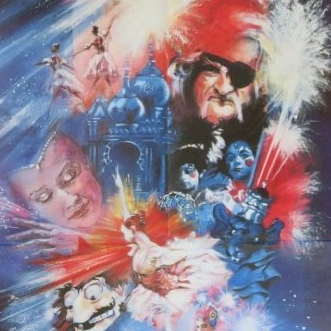The Company of Wolves
Stupid sexy werewolves! Coming over here, stealing our women!

UK poster | Palace Pictures
1984 — UK
A PALACE production, presented by ITC ENTERTAINMENT
Cast: ANGELA LANSBURY with GRAHAM CROWDEN, BRIAN GLOVER, KATHRYN POGSON, STEPHEN REA, TUSSE SILBERG and DAVID WARNER, and introducing MICHA BERGESE and SARAH PATTERSON
Director: NEIL JORDAN
Producers: CHRIS BROWN and STEPHEN WOOLLEY
Executive Producers: STEPHEN WOOLLEY and NIK POWELL
Written by: ANGELA CARTER and NEIL JORDAN
Original work by: ANGELA CARTER
Editor: RODNEY HOLLAND
Cinematographer: BRYAN LOFTUS
Production Designer: ANTON FURST
Art Direction: STUART ROSE
Costume Designer: ELIZABETH WALLER
Music: GEORGE FENTON
Special makeup effects by: CHRISTOPHER TUCKER
© ITC Entertainment
Is there a monster that has as bad a time on film as the werewolf? Not the films themselves necessarily, so much as the werewolf itself. The ability to make render the creature on screen in any convincing fashion has largely eluded Hollywood (or, you know, elsewhere). A lot of effort gets put into the transformation, only for the post-transformation thing to look like crap. I suppose in these modern days of CGI there’s less concern about people clad in silly looking wolf costumes, mind you; not when you can have big ol’ ray-traced wolves floating weightlessly around the place in a differently unconvincing manner.
Anyway, that’s largely by the by. I’m here to talk about The Company of Wolves, a film that largely avoids that whole mess by generally using actual wolves (or at least German Shepherd dogs made up to look like them, depending on the scene) to represent the transformed creature. Based somewhat loosely on Angela Carter’s short story of the same name and co-written by the woman herself, the film remains a popular take on the ‘Red Riding Hood’ story. Also, large swathes of my academic career being on the subject of Angela Carter almost makes me qualified to talk about this film. …Almost.
At present, there are actually only two films based on Carter’s work. This is by far the better known one; there’s also an adaptation of The Magic Toyshop that saw release in 1987, also adapted very loosely by Carter herself. It’s kind of surprising really given her ever increasing reputation, but then again, maybe it’s for the best. I’ve read the script to that stage adaptation of Nights at the Circus that everyone was so hot for fifteen years back and had buzz about a potential film adaptation. I’m guessing you had to be there, because the script as published is fucking awful.
Moving on, this non-hypothetical film concerns young Rosaleen (Sarah Patterson). She does be living in a grubby little hamlet that has the unfortunate problem of being surrounded by a forest, one infested with wolves. Also, you have to go through the forest to get to her grandmother’s house. I mean, obviously. You know that story. Anyway, Rosaleen’s sister gets the killing of a lifetime as a result of a wolf maulin’, however that’s a good Christian death and all so Granny (Angela Lansbury) says it’s fine. Far worse than regular wolves are the other kind who pretend to be human, but inside their aaaaaall wolf, baby! Hmm, it’s like a metaphor or something. Well, it’s not as if these themes aren’t present in the original fairy stories. You can presumably assume how this narrative thread as whole pans out for the most part, but the film’s structure is such that weaved into (and out of) this somewhat simple tale is a complicated web of storytelling as it drifts between different layers of narrative, presenting further tales that may or may not be true within the world that the film presents. Further complicating proceedings is the fact that the world that the bulk of the film apparently takes place in may or may not be the ‘real’ world either; the Red Riding Hood-type narrative is framed as a dream, but the boundaries between that world, the world of the dreamer and the various other stories soon come to blur.
This was the second film directed by Neil Jordan, latterly of The Crying Game (1992) and Interview with a Vampire (1994),* and had a not inconsiderably bigger budget than his previous. Per the BFI, Angel (1982) had a budget of about £470,000 (Pym, 122) and this had nearly two million more (Pym, 132). Still pretty meagre in the grand scheme of things, but it was a British film in the mid-‘80s without any of the major US studios backing; the lion’s share coming from the post-collapse, post-Grade ITC Entertainment; Channel 4 reportedly having turned it down, deeming the script to be both vulgar and too gory (BFI, 2016).** I’m in no real position to compare the production values of the films; I haven’t seen Angel; but it does have a contemporary Irish setting rather than a fantasy setting, so it’s perhaps not really a fair comparison to make. Instead, I suppose we can compare it to Interview with a Vampire against which it stacks up pretty favourably despite having but a tiny fraction of that film’s budget, though I suppose they’re not aiming at quite the same target. The Company of Wolves revels in the unreal artifice of its presentation, with its world resting stylistically somewhere between a Hammer film and The Tales of Hoffmann (1951) era Powell and Pressburger, with some Valerie and her Week of Wonders (1970) thrown in for good measure, why not? Indeed the Valerie comparison is perhaps important; both Jordan and Magic Toyshop director David Wheatley have mentioned the film explicitly coming up in their conversations with Carter (Gordon, 335; 362), and the DNA of Jaromil Jireš’ film, a Gothicised phantasmagoria on a girl’s sexual awakening with monsters (albeit werewolves here rather than vampires; the roles they play being quite different), is very present by the story’s very concept. It presents itself not as a real place, but as a part Wonderland, part toy box, with giant mushrooms and integrated doll houses scattered throughout the forest. The art and lighting design are such that the sinewy trees take on a fleshy appearance in the dark, and the devil (an uncredited Terence Stamp) rides around in a seemingly anachronistic Rolls Royce, though can it really be anachronistic when the period ultimately never was? Of course, the dream nature of the setting means it doesn’t have to conform to an entirely consistent plot, which is perhaps the point. The film rather revels in contradicting itself, making a point to spout various incompatible explanations for what’s occurring, though even then there are many subtle touches that the characters fail to notice don’t entirely add up, such as toads frolicking in the snow being treated as an entirely ordinary occurrence. The world that is readily accepted is perhaps not the world as it is. The conflict is thus between the fanciful granny and the pragmatic parents’ (David Warner and Tusse Silberg) views of the world as they pull Rosaleen in various directions, but it’s ultimately up to her to figure out which of them holds the truth, assuming it’s one or the other, that is, which is itself quite a big assumption.
* Supposedly, he and Carter had planned to reunite to do a vampire picture. If I were to hazard a guess, I’d assume it’d have been based on ‘The Lady of the House of Love’ (1975), as it seems like a story she went back to a fair bit. Anyway, that didn’t happen, what with Carter dying and all. The popular theory is that Jordan did Interview with a Vampire instead to fill his vampire movie desire. This seems rather dismissive and I don’t think there’s any real evidence of it; I just thought I’d mention it. (Frankly, the later Byzantium (2012) feels kind of more like the substitute for the hypothetical vampire film they would’ve made, anyway.) Edmund Gordon's biography makes no mention of a proposed vampire film, but does mention Jordan pitching an adaptation of 'The Cabinet of Edgar Allan Poe' (1982) to her, as well as an anthology film of "tales of sexual intrigue and depravity, each with an ironic moral twist to it" (Gordon, 410-411).
** They apparently changed their mind at some point. The BFI’s study of Film4’s early productions lists the film amongst their work, claiming they threw some £200k in during production (Pym, 132). It is indeed listed on Film4 Productions’ website, despite not being credited within the film itself (…and despite the website omitting quite a few films that they ARE credited in).
At time of writing, The Company of Wolves is available to rent on the BFI Player. I recommend JustWatch for keeping up with where films are streaming (including this one!). Alternatively, physical copies are reportedly available for rent via Cinema Paradiso.
The film has an 18 rating. Its last rating predates them putting details on the website, though I assume it's mostly to do with a rather gory and rather lengthy and detailed transformation sequence.
Sources
Gordon, E. 2016. The Invention of Angela Carter: A Biography. London: Vintage (2017).
Pym, J., 1992. Film on Four – 1982/1991: A Survey. London: British Film Institute.
BFI, 2016. Mark Kermode reviews The Company of Wolves (1984) | BFI Player. [video online] Available at: <https://www.youtube.com/watch?v=lwXImpudjvU> [Accessed 29 September 2020].



